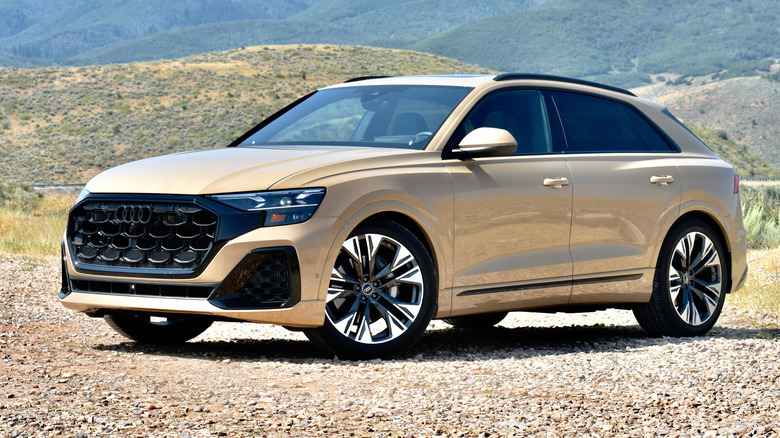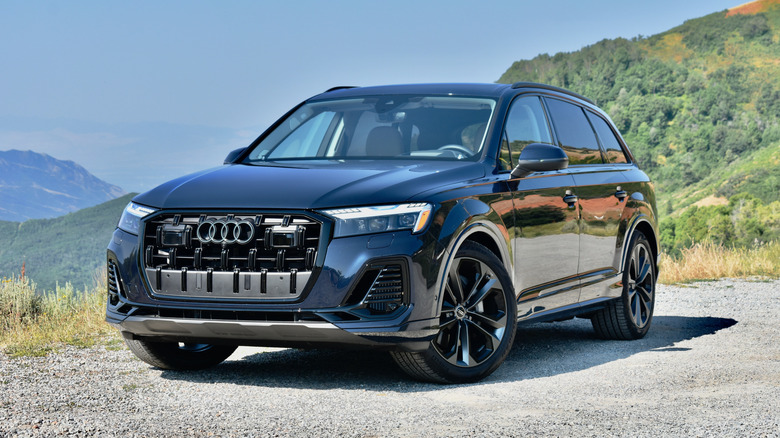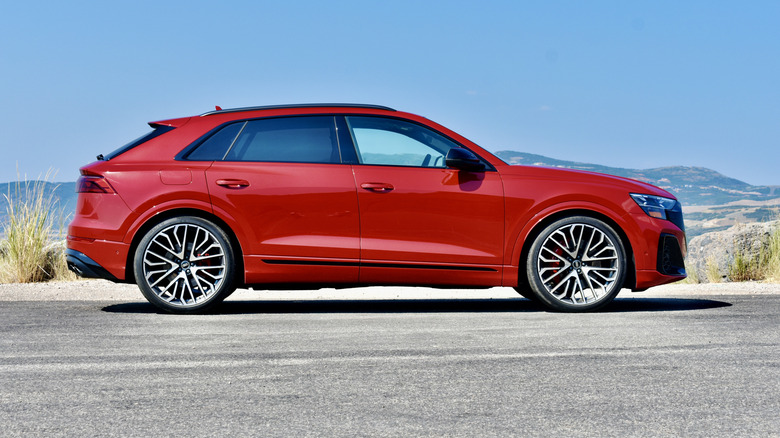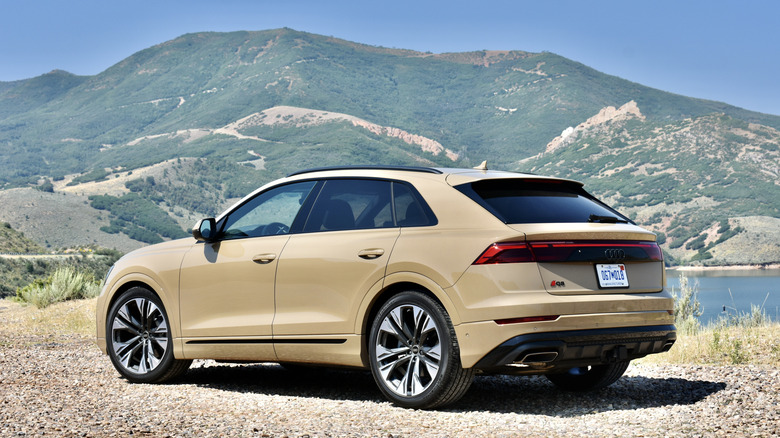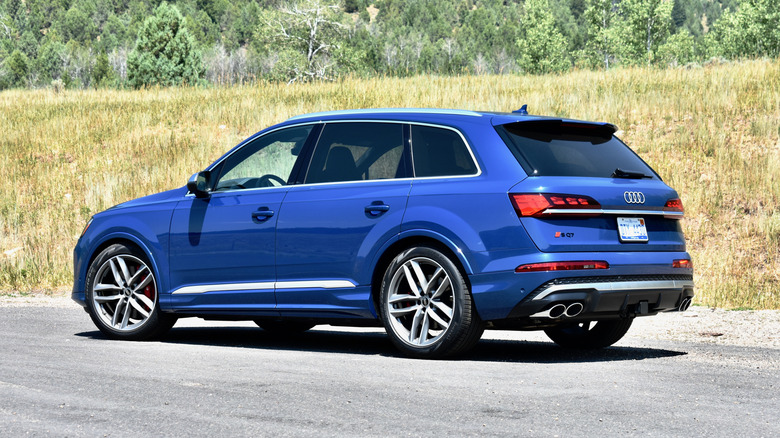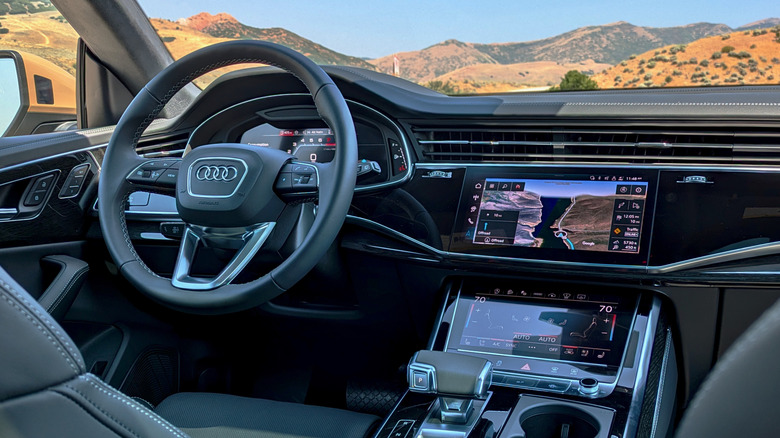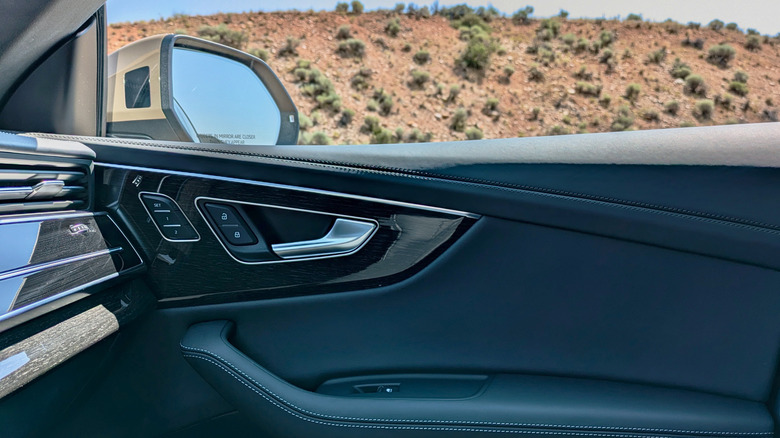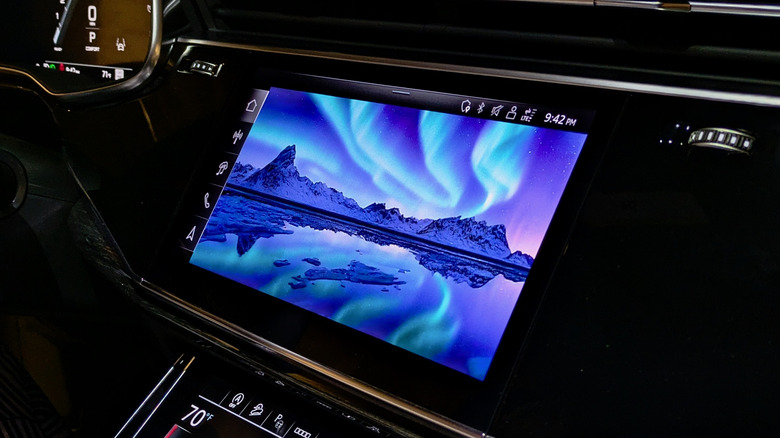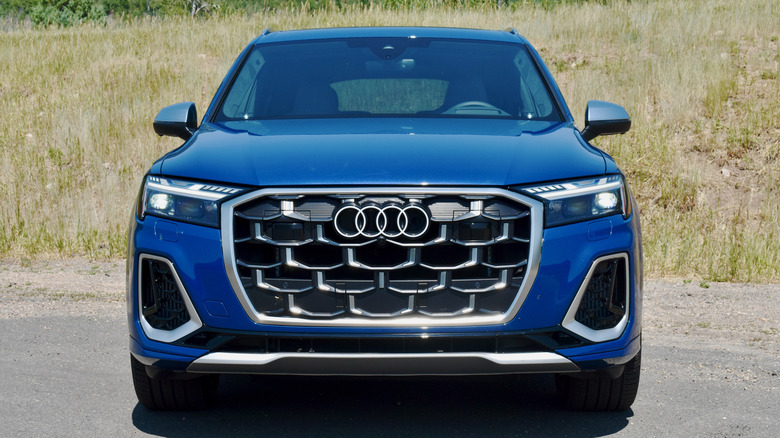2025 Audi Q7 And 2024 Q8 First Drive: Can A Refresh And SQ Speed Justify The Price?
Audi had an admirable history of technological innovation, prioritizing all-wheel drive and dominating motorsports from rallying to the 24 Hours of Le Mans. But most customers don't care about that. They just want SUVs from a recognizable brand to help live out their active lifestyles, tote children, and show off to their neighbors. Audi's got them covered.
The three-row Audi Q7 and two-row Audi Q8, along with their respective SQ7 and SQ8 performance variants, are competent midsize luxury SUVs. The Q7 was Audi's first SUV, and has been around in its current, second-generation form since the 2017 model year. The Q8 joined it as a 2019 model.
Both SUVs are now at the age when automakers would typically be launching redesigns, or at least heavy refreshes. But for now Audi is only applying minor styling and technology updates. Said updates are broadly the same, but were applied to the Q8 for 2024 and the Q7 for 2025. However, Audi also considers the 2024 Q8 described here to be representative of the 2025 model, for which no major changes are planned.
Now with more tech
On the outside, all models sport new grilles with a chain-link-fence like texture, real exhaust tips, and new headlights with four customizable designs for the daytime running lights. Certain models are also available with OLED taillights that are also customizable. Audi offers more sophisticated lighting tech in other markets, but this is all that is allowed under current U.S. regulations.
Inside, Audi now lets customers choose a "theme" for the central touchscreen. Available on all 2023-and-newer vehicles with interior ambient lighting thanks to a software update to the MMI infotainment system, this is essentially a wallpaper for the screen with coordinated light colors. Audi charges $12.99 for this, or $17.99 for one of a series of Major League Soccer themes also on offer.
Transactions are handled through a new Audi App Store, which also allows owners to download third-party apps like Spotify and Amazon Music directly to the car. YouTube is also available, although videos can only be watched while parked.
Styling tweaks over a proven platform
Wearing their new grilles and headlights, the Q7 and Q8 look more truck-like than before. That's particularly true of the boxier Q7, and may be what customers want, but also makes this three-row family hauler less distinctive. The first-generation Q7 and the pre-facelift second-generation model incorporated styling features from the brand's other models for a genuinely Audi look, but now the prominent four-ring badges on the grille and tailgate are doing heavier lifting.
The Q8 still has a hunkered-down profile meant to channel a bit of the classic Audi Quattro, the rally star that more than any other vehicle is responsible for building Audi's reputation. The chopped-off tail and squared-off fenders are indeed Quattro-like, but this is still a generously-proportioned SUV. The use of black trim to make the grille blend into the headlights makes it look even bigger and broader.
Both the Q7 and Q8 are based on the Volkswagen Group's MLB platform, shared with other posh SUVs like the Bentley Bentayga, Lamborghini Urus, and Porsche Cayenne. It's not the newest architecture, but doesn't have any significant shortcomings either.
All-turbo engine lineup
These updates did not included any changes under the hood. So the 2025 Audi Q7 is available in four-cylinder 45 TFSI and six-cylinder 55 TFSI guises, while the Q8 skips the four-cylinder powertrain. An eight-speed automatic transmission and all-wheel drive are standard across the board.
The Q7 45 TFSI is powered by a 2.0-liter turbocharged inline-four that produces 261 horsepower and 273 pound-feet of torque, getting it from zero to 60 mph in an Audi-estimated 6.7 seconds. Both the Q7 55 TFSI and Q8 55 TFSI get a 3.0-liter turbocharged V6 making 335 hp and 369 lb-ft, with identical zero to 60 mph times of 5.5 seconds.
The SQ7 and SQ8 share a 4.0-liter twin-turbo V8 with 500 hp and 568 lb-ft of torque. This further lowers the zero to 60 mph time to 4.0 seconds, while chassis upgrades like standard adaptive air suspension, active anti-roll stabilization, and rear-axle steering raise these SUVs' cornering game.
Driving experience holds up
The Q7 in particular is a fairly aged package by auto industry standards, but still a good one. Interior noise and ride comfort are up to the standards of this market segment, and the MLB platform gives this big Audi a feeling of solidity that further distinguishes it as a premium product. Handling is somewhere between the old school float of a Volvo XC90 and the sharpness of a BMW X5, which seems like a pretty good balance for this type of vehicle.
It's logical to assume that the Q8 is the sportier of the two, as it isn't saddled with a third row, but driven back-to-back the differences were minimal. That's because the base V6-powered Q8 weighs about the same as an equivalent Q7 and both models have nearly identical wheelbases. With the same engine and curb weight, and without a shorter wheelbase to increase agility, there isn't much to set the Q8 apart from its three-row sibling.
We didn't have an opportunity to sample the base four-cylinder Q7 (again, that engine isn't available in the Q8), but we could see why the V6 is positioned as an upgrade. It offers a bit more power than is strictly necessary, while still leaving headroom for the S models' V8 engines. It also enables a 7,700-pound maximum towing capacity in the Q7 that rivals midsize pickup trucks. Even without a trailer behind, though, the transmissions in both the Q7 and Q8 exhibited some roughness at lower speeds.
S models bring power and grins
The SQ7 and SQ8 take things from the sensible to the ridiculous. There was no need for a 500-hp three-row SUV, and uninformed customers will be in for a big surprise when they ask a salesperson for the top-of-the-line model and get handed the key fob to an SQ7. The SQ8 doesn't cause quite as much dissonance between design and performance, but that doesn't diminish the thrill of unleashing all eight cylinders.
Helping drivers to do that without taking unintended excursions into guardrails and trees are a sport rear differential, rear-axle steering, and available summer tires. S models are also available with adaptive air suspension and the active anti-roll system also used by Audi's VW Group siblings Bentley, Lamborghini, and Porsche. This splits the anti-roll bar into two halves, with an electric motor in between. The motor can apply torque to counteract body roll when cornering, and otherwise let each side act independently to reduce motion over bumps.
The test route for the SQ7 and SQ8 consisted of fast sweepers with long straightaways in between—the perfect environment for showcasing these SUVs. The air suspension and anti-roll system were more than up to the challenge of these faster corners, and didn't extract a spine-pummeling penalty of harsh ride quality. That being said, more technical roads with smaller, tighter corners would probably be less fun in these larger vehicles, offering fewer opportunities to make use of their added power while making their size more apparent.
Functional interiors
Interior space is a more relevant topic for midsize SUVs than handling, and it provides another argument for Audi's decision not to update the Q7 and Q8. The Q7 remains competitive with other three-row luxury SUVs like the Volvo XC90 and Infiniti QX60 when it comes to passenger and cargo space. Audi also opted for a 35/30/35 split-folding second row bench seat that allows for five LATCH child-seat tie-down points.
The Q8 sacrifices a bit of practicality to more conventionally-styled SUVs. Its low roof means the Audi offers less headroom than a BMW X5, and it trails the X5 in cargo space as well. However, the Audi's long wheelbase means it offers more legroom than the BMW in both the first and second rows.
The dashboard layouts of the Q7 and Q8 are fairly similar, and well thought-out. However, even by current automaker standards, both SUVs have excessive amounts of shiny silver and piano black plastic trim. Even with the roof's sun shades closed, the glare caused by these trim pieces as downright annoying. The row of buttons between the engine start button and volume knob was a particular focal point for sunlight, bouncing it right into front-seat occupants' line of sight.
Infotainment is no longer novel, but still works
The same basic infotainment layout carries over, meaning the cabins of both the Q7 and Q8 sport three screens each. The driver gets a 12.3-inch digital instrument cluster, while 10.1-inch and 8.6-inch touchscreens stacked on top of each other on the center console handle infotainment and some vehicle functions. Audi's MMI infotainment system includes wireless Apple CarPlay and Android Auto connectivity.
The digital instrument cluster ("Virtual Cockpit" in Audi speak) and lower touchscreen, which defaults to a climate-control menu, were both cutting edge when Audi introduced them a few years ago. But other brands have since adopted similar interfaces, so while the functionality of Audi's tech hasn't diminished, the novelty has. And while haptic controls for the touchscreens make it less likely that you'll press the wrong area of a screen, physical controls would probably be better.
Audi was also ahead of the game in offering services through its in-car screens. Traffic Light Information, which shows when lights are going to change, has been available for some time but now comes free for three years. It only works in certain cities with networked traffic lights, however. Audi's addition of an app store follows current industry trends, although it remains to be seen whether the aforementioned "theme" feature that lets drivers customize their screen backgrounds will catch on.
Returning customers won't be disappointed
Pricing stays within the normal range for midsize luxury SUVs. The 2025 Q7 starts at $61,795 with the four-cylinder 45 TFSI powertrain and $67,095 in V6 55 TFSI guise, while the 2024 Q8 55 TFSI starts at $74,895. The 2025 SQ7 and 2024 SQ8 start at $92,095 and $97,795, respectively. Those prices are really just starting points, though; our SQ7 and SQ8 test cars both carried sticker prices north of $100,000, for example.
The Q7 and Q8 both hold their own against the current crop of midsize luxury SUVs, offering plenty of interior space, posh driving dynamics, and the requisite array of screens. The SQ7 and SQ8 are also tons of fun—if you can find the right driving road. However, the Audi SUVs don't really do anything that elevates them above the competition. Purchase decisions will likely come down to subjective appraisals of things like design and interior layout, or the desire to own a vehicle from a particular brand.
The Audi brand carries a fair amount of prestige, but the updated Q7 and Q8 show that Audi is running out of ways to express it. Software-enabled features like customizable interior themes and exterior lighting signatures are cute, but it's the engineering behind the hardware that builds reputations in the automotive industry. Hopefully Audi—and other automakers—don't forget that.
